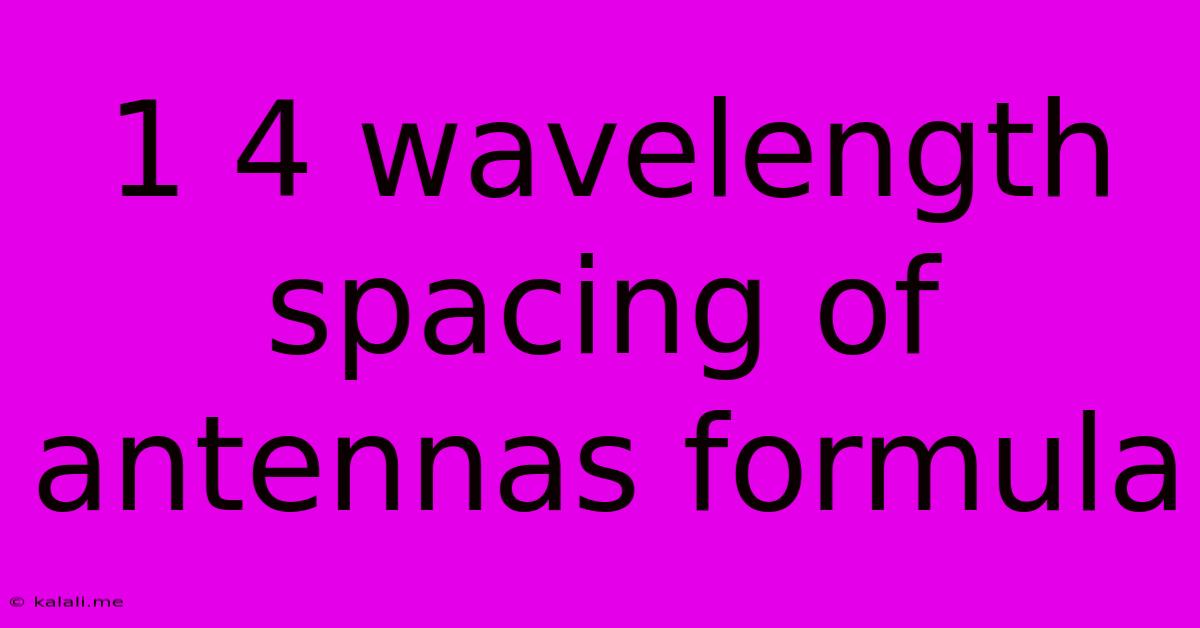1 4 Wavelength Spacing Of Antennas Formula
Kalali
Jun 08, 2025 · 3 min read

Table of Contents
Understanding the 1/4 Wavelength Spacing Formula for Antennas
This article delves into the crucial concept of 1/4 wavelength spacing in antenna design and explains its significance in improving antenna performance. We'll explore the formula itself, its applications, and considerations for its practical implementation. Understanding this principle is key for anyone involved in wireless communication systems or antenna engineering.
What is 1/4 Wavelength Spacing?
In antenna arrays and other multi-element antenna systems, the distance between individual antenna elements significantly affects the overall radiation pattern and performance. One common spacing used is a quarter-wavelength (λ/4), where λ represents the wavelength of the transmitted signal. This spacing is particularly important for applications requiring specific radiation patterns or improved impedance matching.
The Formula and its Implications
The formula itself is relatively straightforward:
Spacing (S) = λ / 4
Where:
- S represents the spacing between antenna elements.
- λ represents the wavelength of the signal.
The wavelength (λ) can be calculated using the following formula:
λ = c / f
Where:
- λ is the wavelength in meters.
- c is the speed of light (approximately 3 x 10<sup>8</sup> m/s).
- f is the frequency of the signal in Hertz (Hz).
Using these formulas, you can determine the appropriate spacing for your antenna elements based on the operating frequency. For example, a system operating at 1 GHz would have a wavelength of approximately 0.3 meters, resulting in a quarter-wavelength spacing of roughly 0.075 meters.
Benefits of Using 1/4 Wavelength Spacing
Several advantages arise from using 1/4 wavelength spacing:
- Improved Directivity: This spacing can help to create a more focused radiation pattern, increasing the signal strength in the desired direction and minimizing interference. This is particularly useful in point-to-point communication.
- Reduced Mutual Coupling: By strategically positioning elements, 1/4 wavelength spacing can minimize the interaction (mutual coupling) between antennas, improving individual antenna efficiency and reducing signal distortion.
- Broader Bandwidth: In some antenna array configurations, this spacing can contribute to a wider operating bandwidth, allowing the system to handle a range of frequencies effectively.
- Simplified Design: The relatively simple calculation makes this spacing easy to implement, simplifying the antenna design process.
Factors Affecting Practical Implementation
While the 1/4 wavelength spacing is a valuable guideline, several factors influence its practical application:
- Antenna Type: The optimal spacing can vary depending on the type of antenna used (e.g., dipole, patch antenna, etc.).
- Ground Effects: Proximity to the ground or other reflecting surfaces can alter the effective spacing and radiation pattern.
- Environmental Conditions: The actual performance can be impacted by environmental factors such as humidity and temperature.
Conclusion
The 1/4 wavelength spacing formula serves as a fundamental principle in antenna design. Understanding its implications and potential limitations allows engineers and technicians to design more efficient and effective antenna systems for various applications. While the formula provides a starting point, careful consideration of other factors and potential variations are essential for achieving optimal performance in real-world scenarios. Remember to always perform simulations and field testing to fine-tune your antenna system for best results.
Latest Posts
Latest Posts
-
Drinks That Will Get You Drunk Fast But Taste Good
Jun 08, 2025
-
Rintuf Air Conditioner Leaking Water From Bottom
Jun 08, 2025
-
How To Apply Screen Protector Without Bubbles
Jun 08, 2025
-
Legend Of Zelda Ocarina Of Time Jar Gorn
Jun 08, 2025
-
The Wifi Network Could Not Be Joined
Jun 08, 2025
Related Post
Thank you for visiting our website which covers about 1 4 Wavelength Spacing Of Antennas Formula . We hope the information provided has been useful to you. Feel free to contact us if you have any questions or need further assistance. See you next time and don't miss to bookmark.